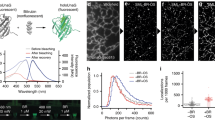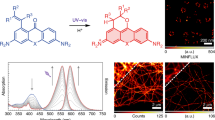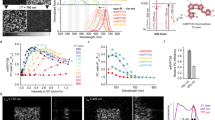Abstract
Fluorescent proteins that can be reversibly photoswitched between a fluorescent and a nonfluorescent state are important for innovative microscopy schemes, such as protein tracking1, fluorescence resonance energy transfer imaging2, sub-diffraction resolution microscopy3,4,5,6,7,8,9 and others. However, all available monomeric reversibly switchable fluorescent proteins (RSFPs) have similar properties and switching characteristics10,11,12, thereby limiting their use. Here, we introduce two bright green fluorescent RSFPs, bsDronpa and Padron, generated by extensive mutagenesis of the RSFP Dronpa10, with unique absorption and switching characteristics. Whereas bsDronpa features a broad absorption spectrum extending into the UV, Padron displays a switching behavior that is reversed to that of all green fluorescent RSFPs known to date. These two RSFPs enable live-cell fluorescence microscopy with multiple labels using a single detection color, because they can be distinguished by photoswitching. Furthermore, we demonstrate dual-color fluorescence microscopy with sub-diffraction resolution using bsDronpa and Dronpa whose emission maxima are separated by <20 nm.
This is a preview of subscription content, access via your institution
Access options
Subscribe to this journal
Receive 12 print issues and online access
$209.00 per year
only $17.42 per issue
Buy this article
- Purchase on Springer Link
- Instant access to full article PDF
Prices may be subject to local taxes which are calculated during checkout




Similar content being viewed by others
References
Chudakov, D.M., Chepurnykh, T.V., Belousov, V.V., Lukyanov, S. & Lukyanov, K.A. Fast and precise protein tracking using repeated reversible photoactivation. Traffic 7, 1304–1310 (2006).
Jares-Erijman, E.A. & Jovin, T.M. FRET imaging. Nat. Biotechnol. 21, 1387–1395 (2003).
Hell, S.W., Jakobs, S. & Kastrup, L. Imaging and writing at the nanoscale with focused visible light through saturable optical transitions. Appl. Phys. A 77, 859–860 (2003).
Hell, S.W. Toward fluorescence nanoscopy. Nat. Biotechnol. 21, 1347–1355 (2003).
Hofmann, M., Eggeling, C., Jakobs, S. & Hell, S.W. Breaking the diffraction barrier in fluorescence microscopy at low light intensities by using reversibly photoswitchable proteins. Proc. Natl. Acad. Sci. USA 102, 17565–17569 (2005).
Betzig, E. et al. Imaging intracellular fluorescent proteins at nanometer resolution. Science 313, 1642–1645 (2006).
Hess, S.T., Girirajan, T.P. & Mason, M.D. Ultra-high resolution imaging by fluorescence photoactivation localization microscopy. Biophys. J. 91, 4258–4272 (2006).
Dedecker, P. et al. Subdiffraction imaging through the selective donut-mode depletion of thermally stable photoswitchable fluorophores: numerical analysis and application to the fluorescent protein Dronpa. J. Am. Chem. Soc. 129, 16132–16141 (2007).
Egner, A. et al. Fluorescence nanoscopy in whole cells by asynchronous localization of photoswitching emitters. Biophys. J. 93, 3285–3290 (2007).
Ando, R., Mizuno, H. & Miyawaki, A. Regulated fast nucleocytoplasmic shuttling observed by reversible protein highlighting. Science 306, 1370–1373 (2004).
Ando, R., Flors, C., Mizuno, H., Hofkens, J. & Miyawaki, A. Highlighted generation of fluorescence signals using simultaneous two-color irradiation on Dronpa mutants. Biophys. J. 92, L97–L99 (2007).
Stiel, A.C. et al. 1.8 A bright-state structure of the reversibly switchable fluorescent protein Dronpa guides the generation of fast switching variants. Biochem. J. 402, 35–42 (2007).
Henderson, J.N., Ai, H.W., Campbell, R.E. & Remington, S.J. Structural basis for reversible photobleaching of a green fluorescent protein homologue. Proc. Natl. Acad. Sci. USA 104, 6672–6677 (2007).
Kogure, T. et al. A fluorescent variant of a protein from the stony coral Montipora facilitates dual-color single-laser fluorescence cross-correlation spectroscopy. Nat. Biotechnol. 24, 577–581 (2006).
Ai, H.W., Shaner, N.C., Cheng, Z., Tsien, R.Y. & Campbell, R.E. Exploration of new chromophore structures leads to the identification of improved blue fluorescent proteins. Biochemistry 46, 5904–5910 (2007).
Andresen, M. et al. Structural basis for reversible photoswitching in Dronpa. Proc. Natl. Acad. Sci. USA 104, 13005–13009 (2007).
Habuchi, S. et al. Reversible single-molecule photoswitching in the GFP-like fluorescent protein Dronpa. Proc. Natl. Acad. Sci. USA 102, 9511–9516 (2005).
Habuchi, S. et al. Photo-induced protonation/deprotonation in the GFP-like fluorescent protein Dronpa: mechanism responsible for the reversible photoswitching. Photochem. Photobiol. Sci. 5, 567–576 (2006).
Chudakov, D.M., Feofanov, A.V., Mudriku, N.N., Lukyanov, S. & Lukyanov, K.A. Chromophore environment provides clue to “kindling fluorescent protein” riddle. J. Biol. Chem. 278, 7215–7219 (2003).
Andresen, M. et al. Structure and mechanism of the reversible photoswitch of a fluorescent protein. Proc. Natl. Acad. Sci. USA 102, 13070–13074 (2005).
Juskaitis, R. & Wilson, T. A method for characterizing longitudinal chromatic aberration of microscope objectives using a confocal optical system. J. Microsc. 195, 17–22 (1999).
Mulholland, J. et al. Ultrastructure of the yeast actin cytoskeleton and its association with the plasma membrane. J. Cell Biol. 125, 381–391 (1994).
Wiedenmann, J. et al. A far-red fluorescent protein with fast maturation and reduced oligomerization tendency from Entacmaea quadricolor (Anthozoa, Actinaria). Proc. Natl. Acad. Sci. USA 99, 11646–11651 (2002).
Hell, S.W. Far-field optical nanoscopy. Science 316, 1153–1158 (2007).
Rust, M., Bates, M. & Zhuang, X. Sub-diffraction-limit imaging by stochastic optical reconstruction microscopy (STORM). Nat. Methods 3, 793–795 (2006).
Schonle, A. & Hell, S.W. Fluorescence nanoscopy goes multicolor. Nat. Biotechnol. 25, 1234–1235 (2007).
Bossi, M. et al. Multicolor far-field fluorescence nanoscopy through isolated detection of distinct molecular species. Nano Lett. 8, 2463–2468 (2008).
Drew, D.E., von Heijne, G., Nordlund, P. & de Gier, J.W. Green fluorescent protein as an indicator to monitor membrane protein overexpression in Escherichia coli . FEBS Lett. 507, 220–224 (2001).
Patterson, G.H., Knobel, S.M., Sharif, W.D., Kain, S.R. & Piston, D.W. Use of the green fluorescent protein and its mutants in quantitative fluorescence microscopy. Biophys. J. 73, 2782–2790 (1997).
De Antoni, A. & Gallwitz, D. A novel multi-purpose cassette for repeated integrative epitope tagging of genes in Saccharomyces cerevisiae . Gene 246, 179–185 (2000).
Acknowledgements
We thank S. Löbermann and J. Schilde for excellent technical assistance and J. Jethwa for carefully reading the manuscript. We acknowledge J.-W.L. de Gier, Stockholm University, Sweden, for providing us with the expression vector harboring the M13-GFP fusion.
Author information
Authors and Affiliations
Contributions
M.A. performed experiments, analyzed data and wrote the manuscript. A.C.S., J.F. and D.W. performed experiments. A.S. and A.E. provided algorithms and software for sub-diffraction resolution microscopy. C.E. constructed the fluorescence microscope utilized for screening. S.W.H. designed research and wrote the manuscript. S.J. analyzed data, designed research and wrote the manuscript; all authors contributed to editing the manuscript.
Corresponding author
Supplementary information
Supplementary Text and Figures
Supplementary Figures 1–11, Tables 1–3, Methods (PDF 1936 kb)
Supplementary Movie 1
3D confocal time lapse imaging of live cells expressing rsFastLime and Padron (MOV 209 kb)
Rights and permissions
About this article
Cite this article
Andresen, M., Stiel, A., Fölling, J. et al. Photoswitchable fluorescent proteins enable monochromatic multilabel imaging and dual color fluorescence nanoscopy. Nat Biotechnol 26, 1035–1040 (2008). https://doi.org/10.1038/nbt.1493
Received:
Accepted:
Published:
Issue Date:
DOI: https://doi.org/10.1038/nbt.1493
This article is cited by
-
Superresolution structured illumination microscopy reconstruction algorithms: a review
Light: Science & Applications (2023)
-
First biphotochromic fluorescent protein moxSAASoti stabilized for oxidizing environment
Scientific Reports (2022)
-
Absolute quantum yield measurements of fluorescent proteins using a plasmonic nanocavity
Communications Biology (2020)
-
Resonance energy transfer sensitises and monitors in situ switching of LOV2-based optogenetic actuators
Nature Communications (2020)
-
Bright ligand-activatable fluorescent protein for high-quality multicolor live-cell super-resolution microscopy
Nature Communications (2020)



